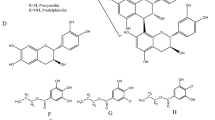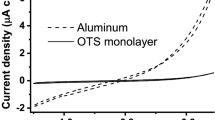Abstract
IT has been shown by Wolstenholme and Schulman1,2 that metal ions such as Fe, Al, Co, Cu interact with fatty acid monolayers over the pH stability range of the basic metal ions. There were indications that the association could be influenced also by the size and shape of both the fatty acid molecule and the basic metal ionic unit. The present communication shows how these ideas can be applied to the chromium ionic system, together with a direct analogy between the interaction of the basic chromium ion, with fatty acid monolayers, and the tanning of a protein monolayer. Here, the reactivity of the carboxyl group is important in both systems.
This is a preview of subscription content, access via your institution
Access options
Subscribe to this journal
Receive 51 print issues and online access
$199.00 per year
only $3.90 per issue
Buy this article
- Purchase on Springer Link
- Instant access to full article PDF
Prices may be subject to local taxes which are calculated during checkout
Similar content being viewed by others
References
Wolstenholme and Schulman, Trans. Farad. Soc., 46, 475 (1950).
Wolstenholme and Schulman, Trans. Farad. Soc., 47, 483 (1951).
Gustavson, “Advances in Protein Chemistry”, 5, 354 (1949).
Cockbain and Schulman, Trans. Farad. Soc., 35, 1225 (1939).
Author information
Authors and Affiliations
Rights and permissions
About this article
Cite this article
SCHULMAN, J., DOGAN, M. Tanning of Fatty Acid and Protein Monolayers by Metal Ions (Cr, Al, Fe and Cu). Nature 170, 31–32 (1952). https://doi.org/10.1038/170031b0
Issue Date:
DOI: https://doi.org/10.1038/170031b0
This article is cited by
-
The effect of certain small molecules on the elasticity of adsorbed serum albumin films
Kolloid-Zeitschrift & Zeitschrift für Polymere (1962)
Comments
By submitting a comment you agree to abide by our Terms and Community Guidelines. If you find something abusive or that does not comply with our terms or guidelines please flag it as inappropriate.



